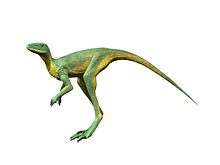Silesauridae
Silesauridae is an extinct clade of Triassic dinosauriformes consisting of the closest known relatives of dinosaurs. As indicated by coprolite contents, some silesaurids such as Silesaurus may have been insectivorous, feeding selectively on small beetles and other arthropods.[1]
| Silesaurids | |
|---|---|
 | |
| Scientific classification | |
| Kingdom: | Animalia |
| Phylum: | Chordata |
| Clade: | Dracohors |
| Clade: | †Silesauridae Langer et al., 2010 |
| Genera | |
| |
Classification
Silesauridae is the sister group to Dinosauria. The group was named in 2010 by paleontologist Max C. Langer et al. They defined it as a branch-based clade of all archosaurs closer to Silesaurus opolensis than to either Heterodontosaurus tucki or Marasuchus lilloensis. At the same time, a second group of scientists independently named Silesauridae as a node-based clade consisting of Lewisuchus, Silesaurus, their last common ancestor and all their descendants.[2] Currently, both definitions encompass the same group of animals. In a later paper, Sterling J. Nesbitt et al. (2010) noted that the earlier definition by Langer et al. did not include a diagnosis, and so was not sufficient to create a ranked family-level name according to the ICZN. Therefore, the family Silesauridae is attributed to Nesbitt et al. (2010) while the clade Silesauridae is attributed to Langer et al. (2010).[3]
The fossils range in age from the Anisian to the Norian stages of the Triassic, about 245 to 203 million years ago.[2][4] The cladogram below follows the phylogenetic analysis of basal ornithodirans conducted by Christian Kammerer, Sterling Nesbitt and Neil Shubin (2012) with clade terminology from Cau (2018) and Martz and Small (2019).[3][5][6]
| Ornithodira |
| ||||||||||||||||||||||||||||||||||||||||||||||||||||||||||||||||||
A large phylogenetic analysis of early dinosaurs and dinosauromorphs carried out by Matthew Baron, David Norman and Paul Barrett (2017) and published in the journal Nature recovered Silesauridae as a monophyletic sister group to Dinosauria. The study also recovered the taxon Agnosphitys within the clade Silesauridae, close to Lewisuchus and its synonymous taxon Pseudolagosuchus.[7]
References
- Martin Qvarnström; Joel Vikberg Wernström; Rafał Piechowski; Mateusz Tałanda; Per E. Ahlberg; Grzegorz Niedźwiedzki (2019). "Beetle-bearing coprolites possibly reveal the diet of a Late Triassic dinosauriform". Royal Society Open Science. 6 (3): Article ID 181042. doi:10.1098/rsos.181042. PMC 6458417. PMID 31031991.
- Nesbitt, Sterling J., Sidor, Christian A., Irmis, Randall B., Angielczyk, Kenneth D., Smith, Roger M.H. and Tsuji, Linda A. (2010) "Ecologically distinct dinosaurian sister group shows early diversification of Ornithodira." Nature 464(7285):95-8 Supplement
- Kammerer, C. F.; Nesbitt, S. J.; Shubin, N. H. (2012). "The First Silesaurid Dinosauriform from the Late Triassic of Morocco". Acta Palaeontologica Polonica. 57 (2): 277. doi:10.4202/app.2011.0015.
- Langer, M.C.; Ezcurra, M.D.; Bittencourt, J.S.; Novas, F.E. (2010). "The origin and early evolution of dinosaurs". Biological Reviews. 85 (1): 55–110. doi:10.1111/j.1469-185X.2009.00094.x. PMID 19895605.
- Andrea Cau (2018). "The assembly of the avian body plan: a 160-million-year long process" (PDF). Bollettino della Società Paleontologica Italiana. 57 (1): 1–25. doi:10.4435/BSPI.2018.01.
- Martz, J.W.; Small, B.J. (2019). "Non-dinosaurian dinosauromorphs from the Chinle Formation (Upper Triassic) of the Eagle Basin, northern Colorado: Dromomeron romeri (Lagerpetidae) and a new taxon, Kwanasaurus williamparkeri (Silesauridae)". PeerJ. 7: e7551. doi:10.7717/peerj.7551. PMC 6730537. PMID 31534843.
- Baron, M.G.; Norman, D.B.; Barrett, P.M. (2017). "A new hypothesis of dinosaur relationships and early dinosaur evolution". Nature. 543 (7646): 501–506. doi:10.1038/nature21700. PMID 28332513.









